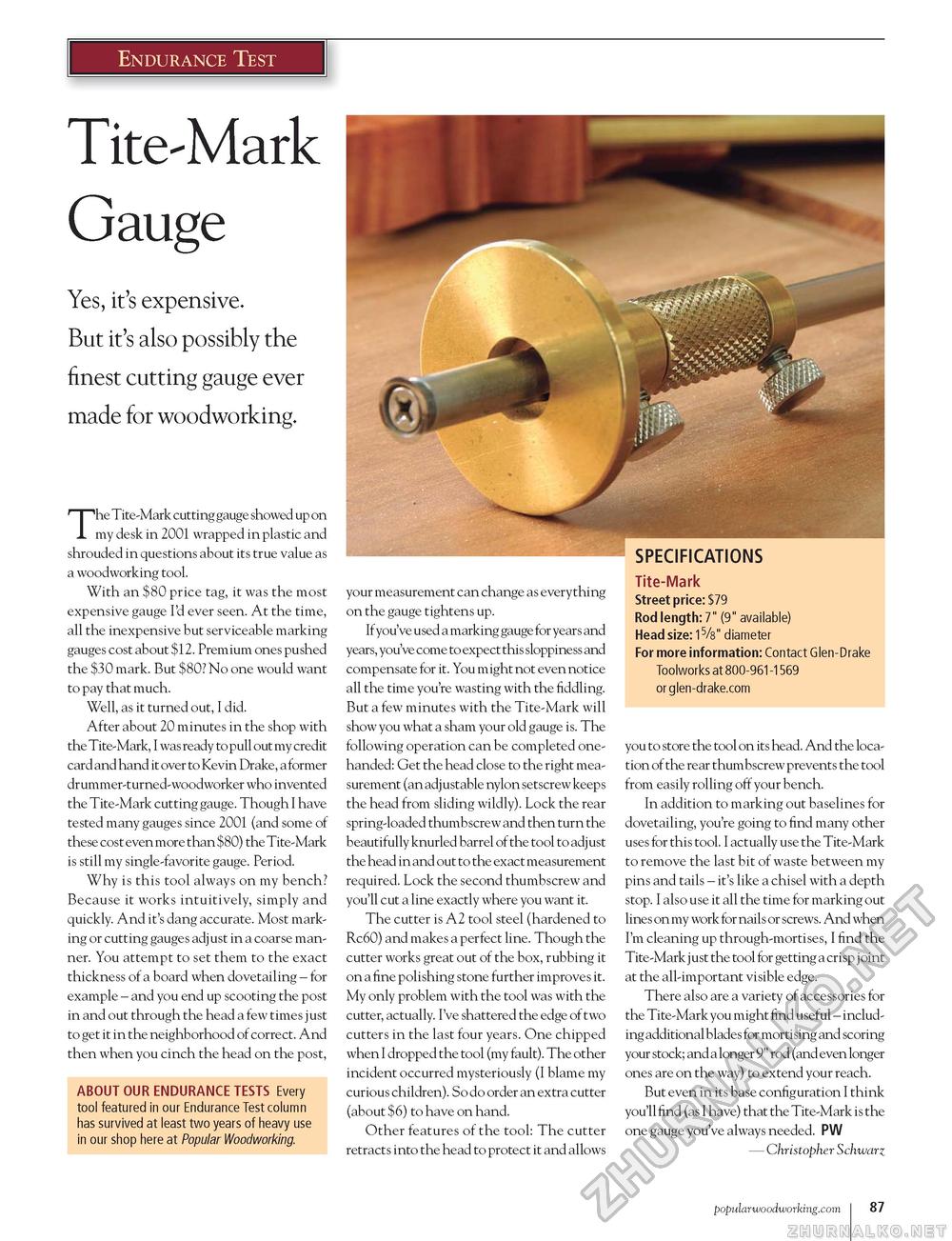Popular Woodworking 2005-12 № 152, страница 86
Endurance Test Tite-Mark Gauge Yes, it's expensive. But it's also possibly the finest cutting gauge ever made for woodworking. The Tite-Mark cutting gauge showed up on my desk in 2001 wrapped in plastic and shrouded in questions about its true value as a woodworking tool. With an $80 price tag, it was the most expensive gauge I'd ever seen. At the time, all the inexpensive but serviceable marking gauges cost about $12. Premium ones pushed the $30 mark. But $80? No one would want to pay that much. Well, as it turned out, I did. After about 20 minutes in the shop with the Tite-Mark, I was ready to pull out my credit card and hand it over to Kevin Drake, a former drummer-turned-woodworker who invented the Tite-Mark cutting gauge. Though I have tested many gauges since 2001 (and some of these cost even more than $80) the Tite-Mark is still my single-favorite gauge. Period. Why is this tool always on my bench? Because it works intuitively, simply and quickly. And it's dang accurate. Most marking or cutting gauges adjust in a coarse manner. You attempt to set them to the exact thickness of a board when dovetailing - for example - and you end up scooting the post in and out through the head a few times just to get it in the neighborhood of correct. And then when you cinch the head on the post, your measurement can change as everything on the gauge tightens up. If you've used a marking gauge for years and years, you've come to expect this sloppiness and compensate for it. You might not even notice all the time you're wasting with the fiddling. But a few minutes with the Tite-Mark will show you what a sham your old gauge is. The following operation can be completed one-handed: Get the head close to the right measurement (an adj ustable nylon setscrew keep s the head from sliding wildly). Lock the rear spring-loaded thumbscrew and then turn the beautifully knurled barrel of the tool to adjust the head in and out to the exact measurement required. Lock the second thumbscrew and you'll cut a line exactly where you want it. The cutter is A2 tool steel (hardened to Rc60) and makes a perfect line. Though the cutter works great out of the box, rubbing it on a fine polishing stone further improves it. My only problem with the tool was with the cutter, actually. I've shattered the edge of two cutters in the last four years. One chipped when I dropped the tool (my fault). The other incident occurred mysteriously (I blame my curious children). So do order an extra cutter (about $6) to have on hand. Other features of the tool: The cutter retracts into the head to protect it and allows Tite-Mark Street price: $79 Rod length: 7" (9" available) Head size: 15/s" diameter For more information: Contact Glen-Drake Toolworks at 800-961-1569 or glen-drake.com you to store the tool on its head. And the location of the rear thumbscrew prevents the tool from easily rolling off your bench. In addition to marking out baselines for dovetailing, you're going to find many other uses for this tool. I actually use the Tite-Mark to remove the last bit of waste between my pins and tails - it's like a chisel with a depth stop. I also use it all the time for marking out lines on my work for nails or screws. And when I'm cleaning up through-mortises, I find the Tite-Mark just the tool for getting a crisp joint at the all-important visible edge. There also are a variety of accessories for the Tite-Mark you might find useful - including additional blades for mortising and scoring your stock; and a longer 9" rod (and even longer ones are on the way) to extend your reach. But even in its base configuration I think you'll find (as I have) that the Tite-Mark is the one gauge you've always needed. PW — Christopher Schwarz ABOUT OUR ENDURANCE TESTS Every tool featured in our Endurance Test column has survived at least two years of heavy use in our shop here at Popular Woodworking. popularwoodworking.com i 87 |








